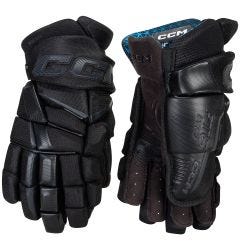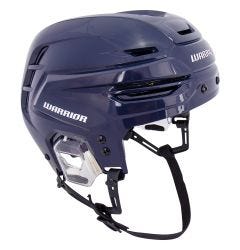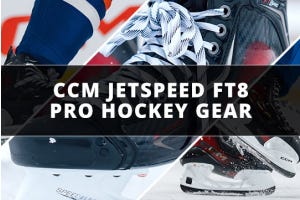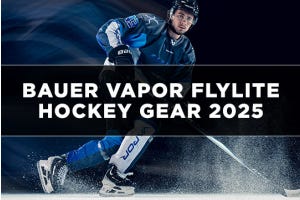Hockey Forwards: A Guide to Playing Left Wing & Right Wing
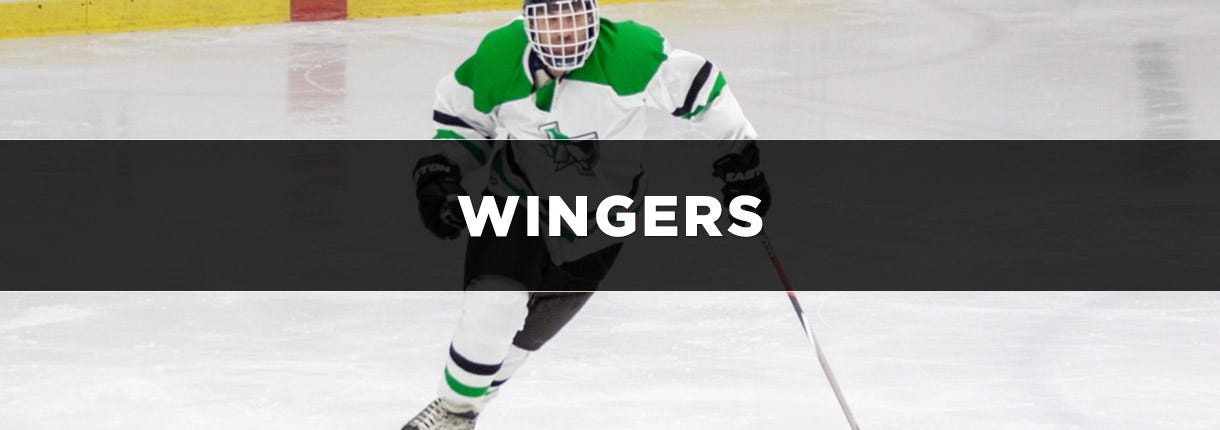
Wingers in Ice Hockey play a crucial role on a team, in terms of generating offense and scoring goals. While these are their primary tasks, Wingers in hockey serve a multitude of different purposes.
What is a Forward/Winger in Hockey?
A winger is typically the one responsible for leading the charge into the offensive zone. These smaller, quicker players are always looking for crafty ways to put the puck in the back of the net. And while scoring goals is their primary objective, Wingers are also responsible for making heads-up plays in the defensive zone, helping lead their teams to fastbreaks and odd-man rushes.
Right Wing vs. Left Wing Position
The game of ice hockey always utilizes two wingers on the ice, a left winger and a right winger. Each one of these wingers will play a majority of the game on their respective sides of the ice, on both offense and defense. The primary objectives between these two positions are the same, with the primary one being to put the puck into the back of opposing nets. That said, often times these two will have differing play styles that will compliment each other. For example, if a team uses a small, quick Right Winger that can snipe corners, they might choose to use a playmaking Left Winger with excellent passing ability so he can feed the Right Winger passes! Additionally, these two will usually play on their off-side. This means that the Left Winger will typically be a right-handed player and the Right Winger will typically have a left-handed shot. The reason for this is to have an increased shot percentage due to being easier to cut to the middle of the zone.
How to Play Left & Right Wing
Offensive Duties
Score
- Putting the puck in the back of the opposing team’s net is a Wingers primary objective. Wingers typically have the best shot on the team, so effectively utilize it to score goals.
- Battle with opposing players along the boards, win pucks, and use your shot to fire the puck on net.
Utilize Stickhandling Abilities
- Going hand in hand with the step above, is to effectively utilize your stickhandling abilities. As a Winger, you will have some of the best stickhandling skills on the team. Use them to your advantage when going against a defender one-on-one and draw him out of position leaving one of your teammates wide open. Strong stickhandling abilities start with the right hockey stick and hockey gloves to ensure you are using the best equipment for you.
- Another option is to use your speed and stickhandling ability to go around him, and drive to the net for a shot. While Wingers don’t have the reach that defensemen have, they are almost always quicker than defensemen, so use that to your advantage to create space and scoring opportunities.
Be active
- Always keep your feet moving and try to stand still as little as possible. Doing so forces defensemen to do the same, and if they aren’t quick enough, could lead to them potentially being out of position for a backdoor pass.
- This includes finding open spaces in the defense, exploiting them, and receiving a pass for a potential scoring chance.
- This also means being active on your feet when a teammate fires a shot on net. There is always a chance that a rebound could bounce off the goalies pads and right onto your stick. Be aware of when he is shooting and crash the net for one of these rebounds.
- Being vocal also helps too. If you cut to the net, and feel like you are open and have a good chance for a potential scoring opportunity, let the puck carrier know by calling for the puck.
Heads-up plays
- Most teams generally like to set plays up while in the offensive zone. This means passing it to teammates around the outside until an open teammate becomes available.
- When you get the puck on your stick in this situation, keep your head up, keep your feet moving, and look for open teammates cutting to the net. If no pass like this is available, continue working it around the zone by passing to your open defenseman or center behind the net.
- Read and understand the play and try to decide what you are going to do with the puck before it arrives to you.
- Be aware of what the defensemen are doing when you don’t have the puck. If one of them turns his back to you and doesn’t keep his head on a swivel, take advantage of this situation by cutting to the open area for a pass and potential scoring chance.
Defensive Duties
Clear the puck
- When the puck is in your defensive zone, it is everyone's responsibility to try to get it out of your zone. This can be done by either skating the puck up the ice if it is stolen, banking the puck off the boards and out of the defensive zone, or by passing it to an open teammate who is skating up the ice.
- As a Winger, you will want to keep your head up in case a pass comes to you (Wingers will be the primary players who carry the puck up the ice), and be sure to play positionally sound, which brings us to our next point.
Positioning
- In the defensive zone, it is recommended that Wingers stay on their side of the ice and generally stay between the blue line and no lower than the faceoff dots. This area is recommended for a few reasons. Being in this area will allow Wingers to effectively cover the opposing team’s defensemen, stopping them from making passes to open teammates or taking shots on net. This area also puts Wingers in a great spot, if their team ends up getting the puck back, to receive breakout passes from their teammates. An example of a Wingers general zone while in the defensive zone can be seen below.
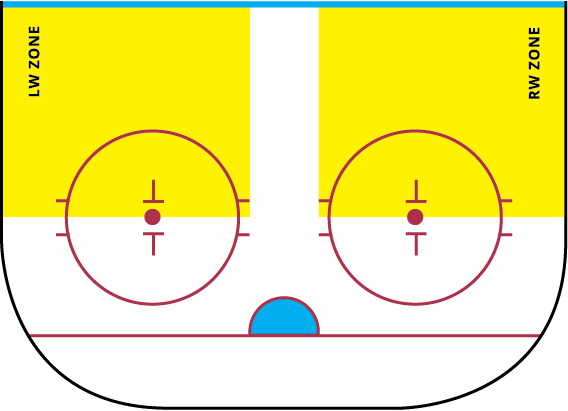
Neutral Zone Duties
Be Aware
- Wingers will be the primary players responsible for carrying the puck through the neutral zone and into the attacking zone. If your team steals the puck in the defensive zone, Wingers should start getting open, while skating up the ice, looking for a breakout pass from (usually) the defensemen.
- A tip here is to keep your stick on the ice as much as possible. If you get a breakout pass from a defenseman, you will want to receive it in stride on your stick blade. Although, some passes won't be right on the mark. If a pass gets sent to your skates, try to quickly kick, or deflect, the puck to yourself and proceed up the ice. You can also adjust your body, allowing yourself to catch the puck on your stick blade.
- There will be times where making a second pass while in the neutral zone is the best option. If you are a Left Winger and catch a pass on the left side of the ice, sometimes the Centerman will be in front of you (known as the head-man) looking to catch a pass in stride and proceed into the offensive zone. Keep your head up, make a split-second decision whether you want to carry it in or pass, and be aware of where the defensemen are.
Penalty Kill Duties
Positioning
- When teams go on the penalty kill, they play with four skaters (Short-Handed) on the ice; Two Wingers and two Defensemen. They play a man down for two minutes, depending on the infraction. The standard Penalty Kill setup is a “box” formation in front of their net, with the two Wingers at the top of the box.
- The primary goal here is to not let the opposing team score, or kill as much time as possible by dumping the puck down the ice. If the opposing team does not score here, the defending team has successfully killed the penalty.
- Stick to your zone and do not overcommit on the puck. Typically you will play a little bit more conservatively here, opposed to when the game is 5-on-5. For example, if the puck goes up to the top corner of the offensive zone, it is not recommended for you to aggressively chase after the puck. This could lead to the defenseman going around you, or making a pass to a now wide-open teammate. If you do veer away from your position, try to get back to it quickly.
- Use your stick to your advantage. Get it in passing lanes, taking away potential passes, and keep it on the ice at all times.
Zone
- Each player on a Penalty Kill has a specific zone or area on the ice that they are responsible for covering. It is similar to 5-on-5 play, except the zones on Penalty Kills are much bigger due to having one less player. The zone for Wingers usually encompasses nearly up to the blue line, to the halfway point of the zone, and no further down than the hash marks of the faceoff circle. Your job as a Winger on a Penalty Kill is to lock down this zone.
- The Wingers are responsible for covering the opposing team’s Defensemen. In doing so, you can help prevent shots from the defensemen, along with passes to and from the defensemen.
- Locking down this zone will ensure that you are in a good position and not susceptible to backdoor passes.
- Communicate with your teammates here, too. This can help improve overall positioning, and awareness (of open opposing players).

Power Play Duties
Be Active
- Power Play duties for Wingers are very similar to their duties on normal 5-on-5 play, and their zones will be identical, some of which include:
- Keep the play moving
- Battling for pucks along the boards
- Keep your head up and look for open teammates
- Fire off well-placed shots
Be Patient
- The objective of a Power Play is not to fire off as many shots as possible. Typically teams on Power Plays will slow the pace down while in the offensive zone and play more tactical by working the puck around the zone, maintaining possession, forcing the opposing players to move and tiring them out. Teams on the Penalty Kill will look to waste as much time as possible, so the longer you possess the puck in their zone, the better.
- As a Winger, you might make more passes while on Power Plays than during regular play, due to working the puck around the zone. Keep your head up, look for open teammates, and use your quickness to try and find open lanes.
- Playing this more methodical style will wear down the opposition as it is never a good idea to make a line change while the puck is in their zone. Using this style of play can lead to higher quality scoring opportunities.
Faceoff Duties
Plan
- Before most faceoffs, Wingers and Centers should very briefly communicate with each other to get an idea of what the Center is planning on doing with the puck on the faceoff. The goal of both Centers is to win it to their respective teams.
- If your Center wins it back to one of your Defensemen, your responsibility as one of the Wingers is to get in the way of the opposing Winger so he does not rush to your Defenseman and steal the puck. The Defenseman can then make a pass to an open teammate up the ice, or take a shot on net.
- If the Center wins the faceoff to a defenseman, you also have the option of skating up the ice and receiving a pass. Sometimes the Center will pop the puck forward. If this happens, you will want to explode off the hash marks, beat the opposing player to the puck, and take a shot on net, or try to skate up the ice with it.
Adapt
- Your Center will not win every single faceoff. If you (the Wingers) plan out a play beforehand with the Center, and it is not won, or he is not able to do exactly what was planned, Wingers should adapt to the play.
- For example, if you are expecting the puck to go to one of your defensemen, and the Centers end up in a stalemate battling for it, you will want to go help him out. The ultimate goal is to gain possession of the puck.






